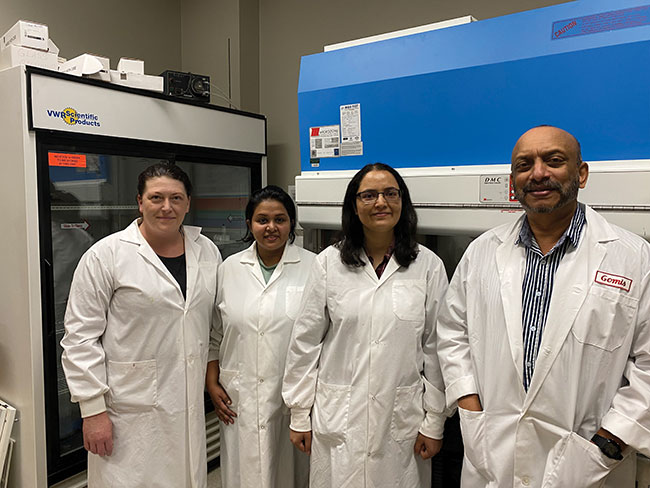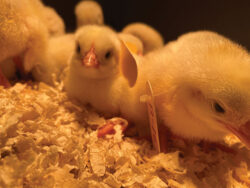
Necrotic Enteritis Research: One and done
By Lisa McLean
Features BroilersBreakthrough would give industry the option to administer a single dose vaccine that rivals the efficacy of preventative antibiotics.
 Susantha Gomis (far right) with laboratory team (left to right): Research Officer Shelly Popowich, and PhD candidates Iresha Subhasinghe and Hemlata Gautam.
Photo: Susantha Gomis
Susantha Gomis (far right) with laboratory team (left to right): Research Officer Shelly Popowich, and PhD candidates Iresha Subhasinghe and Hemlata Gautam.
Photo: Susantha Gomis Canadian poultry producers may soon have access to a new tool to prevent necrotic enteritis (NE) thanks to a research breakthrough that would give industry the option to administer a single dose vaccine that rivals the efficacy of preventative antibiotics.
Susantha Gomis, professor and head of the Department of Veterinary Pathology at University of Saskatchewan’s Western College of Veterinary Medicine, says the vaccine would be administered to chicks before they leave the hatchery and would protect them from NE throughout their broiler lives.
Not all birds are equal
NE is a devastating gastrointestinal poultry disease that causes mortality in young broiler chickens. When an outbreak occurs, a significant number of birds will die within hours or days.
NE usually strikes around three to six weeks of age, after antibodies from broiler breeder parents have faded. Gomis says it is most practical to vaccinate chicks before they leave the hatchery. However, immune system development can be inconsistent at a young age.
“In an ideal world, chickens would respond the same way to the same vaccine – but they are not equal” Gomis says. “We decided to work with an immune stimulant to level the playing field so the birds would be ready to receive the vaccine.”
Immune stimulant
Gomis used an innate immune stimulant; a piece of synthetic DNA known as CpG ODN. Through previous work with CpG ODN, his team was able to demonstrate that birds that received the stimulant performed well when they were challenged with E. coli or S. typhimurium.
“Once we provided proof of concept, we were curious about different delivery options such as intrapulmonary (IPL) delivery of immune stimulants against bacterial infections,” Gomis says.
Gomis’ team developed a nebulizer chamber that allowed them to facilitate IPL delivery of CpG ODN to 8,000 birds at a time. A sample of broiler chicks received the treatment that combined an immune boost of CpG ODN and then they were later challenged with a lethal dose of the E. coli.
Treatment that goes deep
Normal practice for delivering an aerosol vaccine to chickens would target a more shallow delivery, with the vaccine entering the respiratory system at the nostril.

A sample of broiler chicks received the treatment that combined an immune boost of CpG ODN and then they were later challenged with a lethal dose of the E. coli.
Photo: Susantha Gomis
“We usually avoid sending antigens deep down into the trachea and lungs because we are dealing with pathogens. We expected that placing a live bacterium so directly into the bird’s lung would cause them to get sick and die,” he says. “But that’s not what happened.”
When the researchers administered the immune stimulant by the in ovo route prior to delivering inactivated NE bacteria deep into the lungs, the birds did well. Next, the researchers repeated the same process using live bacteria following in ovo delivery of the immune stimulant.
By delivering the immune stimulant by the in ovo route to the amniotic cavity, CpG-ODN goes to the lung of the embryo and Gomis says it spreads quickly through the body and stimulates the innate immune system. Gomis believes the process stimulates the lungs and allows the body to recognize live bacteria quickly when bacteria reach the lung, and then produce an immune response.
“We don’t entirely understand everything about the IPL vaccine delivery in the lung, but we realized the chickens were processing antigens through the lungs efficiently, and traveling to immune organs like the spleen,” Gomis says. “Their bodies were mounting an immune response with that single dose. It was phenomenal.”
New tool in the toolbox
While most vaccines require a booster dose days later, Gomis says with this new IPL vaccine delivery method, together with in ovo delivery of CpG-ODN, a vaccine boost is not necessary.
“We can give CpG ODN in ovo and then a single vaccine at hatch at the hatchery before they go to the farm. This is a single shot vaccine that protects them against NE for their broiler life,” Gomis says.
Gomis says this research represents a major tool in the toolbox as chicken farmers continue to move away from preventative antibiotics. He sees opportunity for additional applications for this approach, particularly for poultry producers in developed countries.
“This is something producers can do, to facilitate with hatcheries to install at a larger scale,” Gomis says. “We know what we need to do, and if industry chooses to, they can work to implement it.”
This research is funded by the Canadian Poultry Research Council as part of the Poultry Science Cluster which is supported by Agriculture and Agri-Food Canada as part of the Canadian Agricultural Partnership, a federal-provincial-territorial initiative. Additional funding was received from Chicken Farmers of Saskatchewan.
Print this page